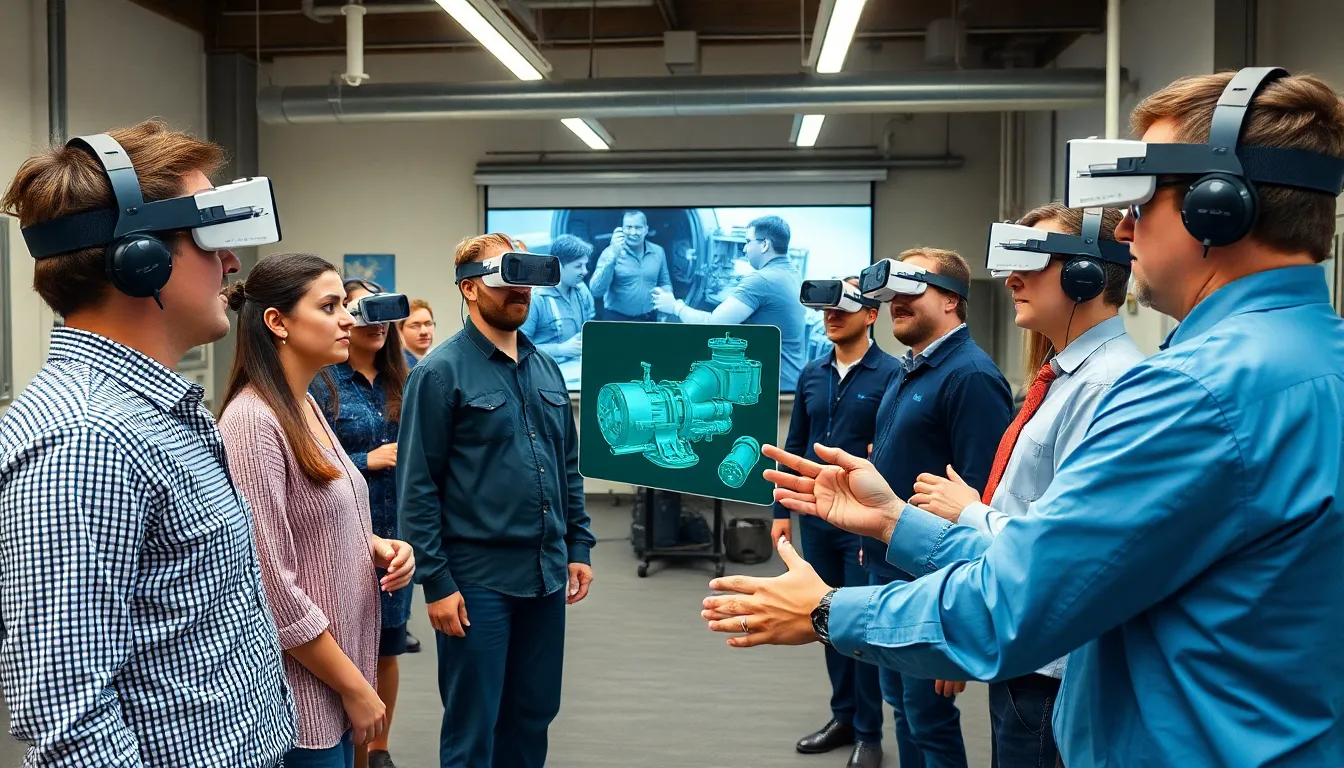In a world where traditional training methods often feel as exciting as watching paint dry, augmented reality training swoops in like a superhero with a flashy cape. It’s not just a buzzword; it’s a game-changer. Imagine stepping into a virtual realm where learning feels less like a chore and more like an adventure, complete with interactive scenarios and instant feedback.
With augmented reality, employees can practice skills in a safe environment, making mistakes without the pressure of real-world consequences. Whether it’s mastering complex machinery or navigating tricky customer interactions, this innovative approach turns training into an engaging experience. So, let’s dive into how augmented reality is reshaping the training landscape and why it might just be the secret sauce your organization needs to spice up its learning programs.
Table of Contents
ToggleOverview of Augmented Reality Training
Augmented reality (AR) training leverages innovative technology to enhance learning experiences. Companies utilize AR to simulate real-world scenarios, allowing employees to engage in practical exercises without real-life risks. Training sessions become immersive, providing users with realistic tasks that mirror their actual work environment.
Interactive elements characterize AR training programs. Participants interact with digital overlays that augment their physical surroundings. For instance, mechanics can receive step-by-step guidance while repairing equipment. This method fosters better retention of information, as employees visualize and enact processes simultaneously.
Real-time feedback plays a crucial role in AR training. Employees receive immediate insights into their performance, facilitating quicker adjustments and improvements. This immediate reinforcement helps solidify knowledge and skills, leading to higher proficiency rates.
Several industries benefit from AR training applications. Healthcare professionals practice surgical techniques using detailed 3D models. In manufacturing, staff gains familiarity with machinery through virtual simulations. Retail employees enhance customer service skills by role-playing scenarios within a lifelike AR setting.
Incorporating AR into training programs results in enhanced engagement. Participants tend to find AR experiences more enjoyable than traditional methods. By increasing motivation, organizations boost completion rates and reduce time spent on training.
Ultimately, AR training revolutionizes how organizations approach employee development. Training becomes more effective and relevant, aligning with the needs of modern workplaces. The shift towards AR signifies a move away from outdated practices, embracing innovation to foster ongoing learning and growth.
Benefits of Augmented Reality Training

Augmented reality training offers significant advantages, making it a valuable tool for enhancing employee learning experiences.
Enhanced Learning Experience
AR provides an immersive environment where complex tasks become more manageable. Learners use interactive visualizations that clarify concepts and procedures. Employees practicing in familiar settings experience reduced anxiety and boosted confidence during training. For instance, a technician repairing equipment receives real-time guidance, reinforcing knowledge retention through active participation. Research shows that learners retain 75% of information when interactive methods are involved. This practical approach also allows for repetition without risks, allowing learners to master skills at their own pace.
Increased Engagement
Engagement levels soar when AR transforms training into a dynamic experience. Participants find themselves immersed in scenarios that require decision-making and critical thinking. The novelty of AR captivates attention and encourages participation. Studies indicate that companies using AR experience a 70% boost in training completion rates. Gamified elements further motivate learners, promoting healthy competition and collaboration. Employees feel more invested in their training, resulting in lower dropout rates and higher retention of knowledge. With AR, companies create an environment where learning feels enjoyable and meaningful, ultimately strengthening workforce capabilities.
Applications of Augmented Reality Training
Augmented reality (AR) training finds applications across various sectors, transforming how professionals acquire skills. This technology holds potential for several industries by providing immersive and effective training experiences.
Industries Utilizing Augmented Reality
Healthcare professionals benefit from AR in areas like surgical training, allowing for live simulations that enhance precision. Manufacturing industries incorporate AR to train workers on complex machinery, guiding them through processes without risks. Retail employees utilize AR to engage with customer service scenarios, boosting interpersonal skills and enhancing sales techniques. Additionally, the military employs AR for tactical training, creating realistic combat simulations that prepare personnel for diverse situations. These sectors illustrate how AR training improves proficiency, engagement, and overall performance.
Case Studies of Successful Implementations
A notable case study involves Boeing, which adopted AR to streamline aircraft assembly, leading to a 40% reduction in training time. The company provided workers with AR headsets that delivered real-time instructions, increasing accuracy. Similarly, DHL integrated AR technology into its logistics operations, resulting in a 15% boost in productivity through faster package sorting. The merger of AR with existing training frameworks proves its value in achieving significant performance gains. Lastly, the University of Maryland Medical Center implemented AR for surgical education, enhancing student knowledge retention and promoting advanced skills development in a controlled environment. These examples highlight AR’s ability to revolutionize training across various domains.
Challenges in Augmented Reality Training
Augmented reality training faces specific challenges that can affect its effectiveness and implementation. Addressing these challenges ensures a smoother integration into learning programs.
Technical Limitations
Technical limitations present hurdles in the deployment of augmented reality training. Hardware deficiencies, such as inadequate processing power and low-resolution displays, hinder user experience. Software incompatibility may lead to glitches during training sessions, disrupting learning. Access to robust internet connectivity also poses challenges, especially in remote areas. A lack of standardized platforms complicates content creation, requiring developers to adapt training materials for different devices and systems. Resolution of these technical issues is essential for realizing the full potential of AR in training environments.
User Acceptance
User acceptance plays a crucial role in the successful adoption of augmented reality training. Some learners resist new technologies due to unfamiliarity or fear of complex interfaces. Perception of augmented reality as a gimmick rather than a valuable tool can hinder engagement and participation. Effective training requires user-friendly design to facilitate learning without overwhelming users. Additionally, organizations should provide thorough training and support to ease the transition for employees. Strategies to build trust and demonstrate clear benefits of AR training can enhance acceptance and participation rates.
Future Trends in Augmented Reality Training
Augmented reality training is entering a phase of rapid evolution, driving new methodologies in various sectors. Innovations in hardware, such as lightweight headsets and advanced smartphones, enhance accessibility for users. Industry leaders are experimenting with integrating artificial intelligence into AR platforms, allowing personalized learning experiences tailored to individual needs.
Use of cloud computing will expand AR training capabilities, enabling seamless updates and collaborative opportunities across locations. Greater incorporation of data analytics will help organizations track employee progress and performance, identifying areas for improvement. Developers are increasingly focusing on creating user-friendly interfaces, making technology more approachable for all skill levels.
Simulations that combine AR with virtual reality may emerge, offering even more immersive environments for practical training scenarios. Adoption of gamification elements will likely rise, increasing user motivation and engagement through competitive elements. Furthermore, AR applications could extend into soft skills training, enhancing communication and teamwork through realistic role-playing exercises.
Predictive analytics will play a crucial role, providing insights into future training needs based on industry trends and employee performance metrics. As remote work becomes more common, AR training will adapt to facilitate virtual team trainings, maintaining connections regardless of distance. Organizations embracing these trends position themselves to revolutionize their training approaches, supporting continuous development and organizational growth.
Integration of AR training into existing learning management systems is also expected, enhancing usability and streamlining processes for learners and administrators alike.
Augmented reality training is reshaping how organizations approach employee development. By creating immersive and engaging learning environments, AR not only enhances skill retention but also boosts confidence among learners. The ability to practice in realistic scenarios without the associated risks allows employees to refine their skills effectively.
As technology continues to advance, the potential for AR training will only grow. Organizations that leverage these innovative methods are likely to see improved performance and engagement. Embracing AR training paves the way for a more dynamic and effective approach to workforce development, ensuring that employees are well-prepared for the challenges of their roles.


